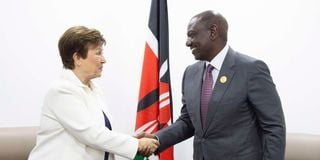Premium
President Ruto cuts subsidies to zero on IMF conditions

President Ruto meets with IMF Managing Director Kristalina Georgieva on the sidelines of COP27 in Sharma El-Sheikh, Egypt onSeptember 21, 2023. The removal of subsidies has been a key condition set by the IMF.
The government cut subsidy spending to zero in the first quarter to September as President William Ruto implemented conditions by the International Monetary Fund (IMF) to end the support plans.
The State had budgeted to spend Sh24.87 billion on subsidies, mainly fertiliser, in the 2023/24 financial year, but the spending did not materialise between July and September.
This is a sharp contrast to the first quarter of 2022/23 financial year, during which the government had already splashed Sh43.91 billion on subsidies on maize flour, fuel, electricity, and fertiliser.
But the consequences of the subsidy withdrawal are already being felt by consumers, especially through historic high fuel prices which have pushed up inflation over the past year.
Fuel inflation slightly increased to contribute 2.2 percentage points to year-on-year overall inflation in September 2023 from a contribution of 2.1 percentage points in September 2022.
“The increase reflects the gradual withdrawal of the fuel subsidy from September 2022 and the upward adjustment of electricity tariff from April 2023,” Treasury said in its latest economic and budgetary review.
Dr Ruto swiftly ended and commenced a probe into a controversial short-term maize flour subsidy programme when he took office in September last year. The subsidy had been put in place by former President Uhuru Kenyatta during his last month in office to reduce maize flour prices ahead of the elections in August.
A probe by Members of Parliament (MPs) in March found that Sh7.26 billion had been spent on the maize flour subsidy out of which Sh4 billion had already been paid to millers.
Dr Ruto also ended a subsidy programme on electricity where power prices had been cut by 15 percent from January last year.
The government committed to pay Sh14 billion in subsidies to Kenya Power to cushion it from the blow it suffered from the price cut.
The Head of State in May also ended the subsidy on fuel, with only monies collected from fuel sales through the Petroleum Development Levy (PDL) now the primary source of funds for stabilisation of fuel prices.
The one cushion that has been retained by Dr Ruto is the fertiliser subsidy, which he has maintained is key to lowering the cost of food production and, therefore, does not count as a consumption subsidy.
The President last year cut fertiliser prices to Sh3,500 from Sh6,500 for a 50-kilogramme bag through a subsidy. In August this year, he slashed the price further to Sh2,500 ahead of the short rains planting season in October.
“Growth in the first half of 2023 was primarily underpinned by a rebound in agriculture activities, following improved weather conditions and the impact of fertiliser and seed subsidies provided to farmers by the government,” the Treasury said.
The lender last week urged Kenya to forge ahead with its prescribed austerity measures to limit non-essential public spending with a focus on digitising government services, enhancing the efficiency of public investments, and better targeting of subsidies.
“Expenditure rationalisation will need to continue, with a focus on enhanced efficiency of public investments, better targeting of subsidies and transfers, addressing weakness in state corporations, and digital delivery of public services,” said IMF mission chief to Kenya Haimanot Teferra.





